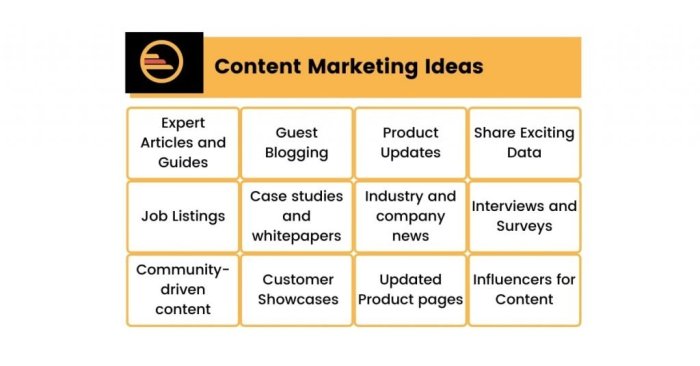Content Marketing Ideas take the spotlight, offering a fresh perspective on crafting engaging strategies that set brands apart in the digital landscape. Dive into this vibrant world where creativity meets strategy, and discover how innovative ideas can elevate your brand’s presence.
Explore the various types of content marketing ideas, learn how to generate impactful concepts, and master the art of implementing these ideas effectively across platforms.
Overview of Content Marketing Ideas

Content marketing ideas are the secret sauce to a successful digital strategy. They help brands stand out in a crowded market, engage with their audience, and drive meaningful interactions. Without innovative content marketing ideas, brands risk blending in with the noise and getting lost in the sea of information available online.
Examples of Successful Content Marketing Campaigns
When it comes to successful content marketing campaigns, creativity is key. Take the example of Red Bull’s Stratos campaign, where they sponsored Felix Baumgartner’s record-breaking freefall from the edge of space. This daring stunt not only captured the world’s attention but also showcased Red Bull’s brand values of adventure and excitement.
Another great example is Dove’s Real Beauty campaign, which challenged traditional beauty standards and promoted body positivity. By creating empowering and relatable content, Dove was able to connect with their audience on a deeper level and differentiate themselves in the beauty industry.
How Content Marketing Ideas Differentiate a Brand
In a crowded market, it’s crucial for brands to find unique ways to connect with their audience. Content marketing ideas allow brands to showcase their personality, values, and vision in a way that resonates with consumers. By creating memorable and engaging content, brands can differentiate themselves from competitors and build a loyal following.
Types of Content Marketing Ideas
Content marketing ideas come in various forms, each designed to engage and resonate with the target audience in unique ways. From interactive content to storytelling and user-generated content, the possibilities are endless when it comes to creating compelling and effective content strategies.
Interactive Content
Interactive content is a powerful tool that allows users to actively engage with the material, rather than passively consuming it. This type of content can include quizzes, polls, calculators, and interactive videos. By involving the audience in the content, brands can increase user engagement, build brand awareness, and drive conversions.
Storytelling
Storytelling is a timeless technique that allows brands to connect with their audience on a deeper, emotional level. By crafting compelling narratives that resonate with the target audience, brands can create a lasting impact and build stronger relationships with their customers. Through storytelling, brands can humanize their message and make it more relatable and memorable.
User-Generated Content
User-generated content (UGC) is a valuable asset for brands looking to build trust and authenticity with their audience. By encouraging customers to create and share content related to the brand, companies can leverage the power of social proof to influence purchasing decisions. UGC can take the form of reviews, testimonials, social media posts, and user-generated videos, among others.
Role of Creativity, Content Marketing Ideas
Creativity plays a crucial role in developing unique and innovative content marketing ideas. By thinking outside the box and pushing boundaries, brands can capture the attention of their audience and differentiate themselves from competitors. Creative content is more likely to stand out in a crowded digital landscape and leave a lasting impression on consumers. Whether it’s through clever visuals, storytelling, or interactive elements, creativity is key to creating memorable and effective content marketing campaigns.
Generating Content Marketing Ideas

When it comes to brainstorming fresh content marketing ideas, creativity is key. Understanding your target audience is crucial in coming up with content that resonates with them. Utilizing tools and methods can help streamline the ideation process for successful content marketing campaigns.
Techniques for Brainstorming
To generate content marketing ideas, consider techniques like mind mapping, reverse brainstorming, or using the SCAMPER method. These approaches can help spark creativity and lead to innovative content concepts.
Understanding the Target Audience
Before brainstorming content ideas, conduct thorough research to understand the demographics, interests, and pain points of your target audience. Tailoring your content to address their needs and preferences will increase engagement and drive results.
Tools and Methods for Ideation
Utilize tools like Google Trends, BuzzSumo, or social media analytics to identify trending topics and popular content formats. Conduct surveys, interviews, or focus groups to gather direct feedback from your audience and generate content ideas based on their input.
Implementing Content Marketing Ideas
Implementing content marketing ideas effectively requires careful planning and execution to ensure they align with overall marketing goals and objectives. By following best practices, you can successfully execute content marketing ideas across different platforms.
Aligning Content Marketing Ideas with Marketing Goals
Before implementing any content marketing ideas, it is crucial to align them with your overall marketing goals and objectives. This ensures that your content efforts are focused and contribute to the success of your marketing strategy.
- Identify your marketing goals and objectives.
- Understand your target audience and their needs.
- Create content that resonates with your audience while also supporting your marketing goals.
- Measure the performance of your content against your marketing objectives and make adjustments as needed.
Executing Content Marketing Ideas Across Platforms
When executing content marketing ideas across different platforms, it is essential to tailor your approach to each platform while maintaining consistency in messaging and branding.
- Adapt your content for each platform to maximize engagement.
- Utilize different types of content, such as videos, blogs, social media posts, and infographics, to reach a broader audience.
- Engage with your audience by responding to comments, messages, and feedback in a timely manner.
- Monitor the performance of your content on each platform and optimize based on the results.












